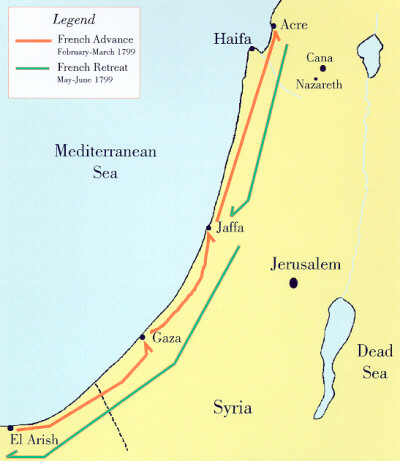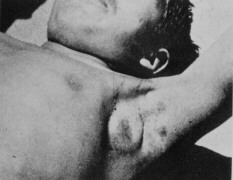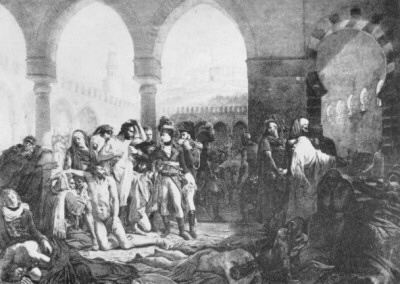The Napoleonic Campaigns and Historical Perception
Robert K. D. Peterson
This article is reprinted and adapted from Peterson, R. K. D. 1995. Insects,disease, and military history: the Napoleonic campaigns and historical perception. American Entomologist. 41:147-160.
The article is copyrighted by the Entomological Society of America and is reprinted with permission. Other reproduction of this material is prohibited.
Section III Plague and the Syrian Campaign
Napoleon's successful campaigns in Italy convinced the Directory that he should invade France's mortal enemy, England. However, in 1798, England's naval strength was superior and Napoleon knew he could not invade. Therefore, he proposed a much safer, and less career threatening campaign--the invasion of Egypt. In his memoirs, he wrote:
"The principal object of the French expedition to the East was to check the power of the English. The army which was to change the destiny of India, was to march from the Nile. Egypt was to supply the place of Saint-Domingo and the Antilles, and to reconcile the freedom of the blacks with the interests of our manufacturers. The conquest of this province would have produced the ruin of all the English settlements in America and the Peninsula of the Ganges." (Clair 1948).

Figure 4. Map of Syrian campaign of 1799. Napoleon entered Syria from Egypt with 13,000 troops, quickly taking the towns of Gaza, Jaffa, and Haifa. Plague struck French soldiers in all of these towns, as well as Acre, which Napoleon was not able to conquer (Redrawn from Herold 1962).
On 19 May 1798, Napoleon and 35,000 troops set sail for Alexandria, Egypt. After conquering Malta, a strategic island in the Mediterranean, he landed in Alexandria on 1 July, narrowly avoiding the British fleet led by Admiral Horatio Nelson. Alexandria and Cairo soon belonged to the French. British naval power, however, proved to be too strong for Napoleon; on 1 August, Admiral Nelson destroyed the French fleet at Abukir Bay. Napoleon was isolated, but he continued the occupation and administration of Egypt.
Early in 1799, the Ottoman Empire declared war on France. Napoleon expected a Turkish attack on Egypt. He decided to enter Syria (now Israel and Syria) to disrupt any Turkish action against Egypt. Bonaparte personally led 13,000 French soldiers into Syria, quickly taking the coastal towns of El Arish, Gaza, Jaffa, and Haifa from Mameluke, Arab, and Turkish defenders (Fig. 4).
The storming of Jaffa was a grisly affair. Jaffa (now incorporated into Tel-Aviv) had experienced centuries of war before Napoleon arrived. It was originally a Phoenician city and was occupied by Egypt in 1472 B.C. Alexander the Great conquered Jaffa, and the Roman emperor Vespasia destroyed it. During the twelfth century, several battles between the Crusaders and Muslims were fought in and around the city. When Napoleon invaded Syria, Jaffa was controlled by the Ottoman Empire.
The French army was not the first to invade Jaffa, but it was particularly brutal to its inhabitants. Although the French took control of the city within a few hours after the attack began, the soldiers' aggression became wildly out of control. They bayoneted approximately 2,000 Turkish soldiers who were trying to surrender. The soldiers' ferocity then turned to the inhabitants of the town. Men, women, and children were robbed and murdered with wild abandon. The insanity continued for three days, ending when Napoleon ordered that 3,000 Turkish troops be executed, those who had surrendered believing they would be held as prisoners of war, be executed (Herold 1962).
During the grievous action in Jaffa, the first French soldiers became delirious with severe fevers and headaches. After a few days, hundreds of soldiers had swellings under their arms. Plague had come to Jaffa.
Bubonic Plague

Figure 5. Bubonic plague victim with bubo under arm (U.S. Armed Forces Institute of Pathology).
Plague is among the more virulent infectious diseases. Its association with humans is an ancient one. The disease is caused by a bacterium, Yersinia pestis (Lehman & Neumann). The pathogen is transmitted by fleas, particularly the oriental rat flea, Xenopsylla cheopis (Rothschild), but it also can be transmitted from human to human in its pneumonic form (a lung infection).
Plague primarily is a disease of rodents. Under certain circumstances, however, plague can be introduced to humans, where it is devastating. Fleas that have fed on plague-infected rats or other rodent species become infected. Plague bacilli multiply in the gut of the flea, and, if humans are in close association with infected rats, the fleas may attempt to feed on them. During feeding, the plague bacilli are introduced into the victim. In humans, after the bacteria are introduced, the onset of the disease usually occurs in three to four days. The disease is characterized by a rapid rise in temperature to approximately 41 oC. Headaches and delirium quickly follow. The swelling, or bubo, typically can be observed on the second day. The tender buboes are swellings of the lymph glands (Fig. 5). The infection then spreads from the lymph nodes to the blood stream, and then to the liver and spleen. A secondary pneumonia may develop because of the deposit of bacteria in the lung tissues. A patient may die in less than 24 hours. During the Syrian campaign, the mortality rate from plague was 92% (Herold 1962).
Plague had already made appearances in the Egyptian campaign, but it was very localized, affecting only small garrisons in Damietta, Rosetta, Abukir, and Alexandria. However, at Jaffa, plague threatened the entire French army. On the second day after the occupation of Jaffa, 31 soldiers were hospitalized with the disease and 14 were already dead (Desgenettes 1802). Detroye, a French officer, wrote in his diary, "In General Bon's division a disease accompanied by buboes has broken out which leads to sudden death. The doctors assure us that it is not the plague." And two days later he wrote, "It is a violent fever with buboes...Many soldiers have succumbed to it and died very suddenly. This illness has been taken for the plague, and this opinion is so widespread that four men, who had its symptoms, have committed suicide." (La Jonquiére 1899).
The French doctors knew they were dealing with bubonic plague from the beginning (Herold 1962). However, they did not want to panic the soldiers so they assured them it was not the plague. This did not work; the soldiers knew what the frightening buboes meant. Plague was a disease dreaded by all Europeans. Napoleon especially feared plague because he recognized that it could destroy his entire army. Oddly, Napoleon believed that fear of plague caused it to spread even more rapidly. He is attributed as saying, "During the Egyptian campaign all those whose imagination was struck by fear died of it. The surest protection, the most efficacious remedy, was moral courage...The best way to preserve the army from the disease was to keep on the march and occupied. Diversion and fatigue were found to be the best prevention." (Malus 1892).
Napoleon was not only a brilliant general, he also was a gifted politician. He knew that to counteract the soldiers' terror of plague, he must go to the plague hospital and visit the patients to show his soldiers that he did not fear the disease. René-Nicolas Desgenettes, a medical officer with the Egyptian expedition, witnessed the visit:
"On March 11, 1799, General Bonaparte, followed by his general staff, felt it incumbent upon himself to visit the hospital...The General walked through the hospital and its annex, spoke to almost all the soldiers who were conscious enough to hear him, and, for one hour and a half, with the greatest calm, busied himself with the details of the administration. While in a very small and crowded ward, he helped to lift, or rather to carry, the hideous corpse of a soldier whose torn uniform was soiled by the spontaneous bursting of an enormous abscessed bubo." (Desgenettes 1802).

Photo captiNapoleon visits the plague hospital (pestifery) in Jaffa.on.
Napoleon's visit clearly had its intended effect; there was less fear among the troops and morale was bolstered. Napoleon never contracted plague, although the same could not be said for many of his other officers, including Adjutant-General Grézieu. Three days after Napoleon's visit to the hospital, he and the main army left to take Haifa and Acre. General Bonaparte ordered General Grézieu to remain in Jaffa with 150 troops and 300 plague-stricken soldiers. Within one day, Grézieu contracted plague and died (Herold 1962).
Etienne-Louise Malus, in charge of the plague hospital, wrote:
"For ten days, I went there assiduously and spent every morning in the loathsome stench of that cloaca, every corner of which was crowded with patients. It was only on the eleventh day that I noticed the symptoms of the plague. This was about the time when Adjutant-General Grézieu died. Half of the garrison already had been stricken by then. About thirty men died every day...About one man among twelve stricken survived...The plague was in every house of the town...The monks of the Capuchin monastery quarantined themselves, to avoid contagion. Almost all of them died." (Malus 1892).
Astonishingly, Malus survived these horrific circumstances. The French doctors did the best they could to prevent the spread of plague. This was difficult because the cause of plague would not be identified for another 100 years. Prevention techniques developed by Desgenettes and Larrey included changing the position of camps, isolating the plague victims, and having the soldiers keep as clean as possible.
After taking Haifa, Napoleon laid siege to Acre, a fortified coastal city now part of Israel. Strong Turkish forces, under the Bosnian, Djezzar Pasha, held Acre. Napoleon was at a great disadvantage because he did not control the coastline near Acre; it was controlled by the British Navy. Therefore, the British continually supplied Acre with food, ammunition, and soldiers. Napoleon certainly was not in the best position to conduct proper siegecraft.
Plague had followed the French army to Haifa, and it was present inside the besieged Acre. At the plague hospital on Mount Carmel, near Haifa, more patients were arriving every day. Napoleon tried to take Acre for two long, bloody months. However, he could not overcome the formidable defenses. A long siege and more plague victims caused morale to sink to a very low level. After a final unsuccessful assault, he decided to return to Egypt.
Napoleon used plague as an excuse for lifting the siege of Acre. He wrote to the Directory:
"The occasion seemed to favour the capture of Acre, but our spies, deserters, and our prisoners all reported that the plague was ravaging the city and that every day more than sixty persons were dying of it...If the soldiers had entered the city...they would have brought back into the camp the germs of that horrible evil, which is more to be feared than all the armies in the world." (Howard 1961).
Napoleon failed to mention that plague was already ravaging his army well before they laid siege to Acre. When it suited his interests, Napoleon did relate to the Directory that "...six months ago plague broke out in Alexandria with very pronounced symptoms. At Damietta it was milder, at Gaza and Jaffa, worse. It has not appeared at Cairo or Suez, nor in Upper Egypt." (Herold 1962).
On the grueling return to Cairo, more men contracted plague and died on the desert sands. Ships were not available to transport the sick; and the few ships that were available were unequipped for the purpose (Herold 1962). Bourienne, Napoleon's chief secretary, recounted the horrible scene:
"I have seen...plague-stricken men, or people merely suspected of having the plague, being abandoned in fields...The dying, by the roadside, were saying in a barely audible voice, 'I am only wounded, I haven't got the plague,' and in order to convince those who were marching by they opened their wounds or inflicted fresh ones on themselves. Nobody believed them. People said, 'He's a dead man,' and passed by...To our right was the sea; to our left and behind us, the desert we were creating; ahead of us, the sufferings and privations that awaited us." (Bourienne 1836).
When the army reached Jaffa, Napoleon, worried that the Turks would catch his army, consulted with Desgenettes. According to Desgenettes, Napoleon said, "If I were in your place, I should put an end to the sufferings of our plague patients and, at the same time, to the danger they represent for us, by giving them [an overdose of] opium." (La Jonquiére 1899). Desgenettes, however, disagreed, relating to Bonaparte that his duty was to preserve life. Bonaparte stated that his duty was to preserve the army. Napoleon said, "I shall not try to overcome your scruples, but I believe I shall find people who will appreciate my intentions more than you do." (La Jonquiére 1899).
Napoleon was clearly worried about the survival of his army. On May 27, 1799, he ordered that the remaining plague patients at Jaffa be poisoned. According to Bourienne, "Napoleon paced rapidly through the wards, striking the yellow cuffs of his boots with a riding whip...'The Turks will be here in a few hours [he said]. Let all those strong enough to get up come with us; they will be carried on litters and horses'...The complete silence and apathy of the men...announced their imminent end." (Bourienne 1836).
What happened next is surrounded in controversy. Napoleon definitely gave orders to poison the 50 or so remaining soldiers. Dr. Desgenettes refused, so Royer, the chief pharmacist, administered the doses of laudanum. There is no record of any of the soldiers dying from the poison, although several claim to have survived the poisoning and the plague. Indeed, the Turks apparently found seven soldiers alive at the hospital when they entered Jaffa. The French soldiers recovered from plague and were cared for by the British navy (Herold 1962).
The Syrian campaign was over. Napoleon and the remains of his army returned to Cairo. Napoleon sailed to Europe on 24 August 1799 to meet his destiny. Although the figures are incomplete, the archives of the French Ministry of War indicate that French casualties in Syria included at least 1,200 killed in action, 1,000 dead from disease, and 2,500 ill or seriously wounded. In all, 2,000 soldiers may have died from bubonic plague during the entire Egyptian expedition (Herold 1962).
Although bubonic plague was not a key factor in determining the failure of the French to take all of Syria from the Turks, it was no doubt a contributing factor. Its presence seems to have influenced Napoleon's decision to return to the relatively safe confines of Egypt. Moreover, plague was greatly feared by the officers, soldiers, and doctors and it affected their morale.
Causes of the Epidemic
Many factors contributed to the outbreak of plague during the Syrian campaign. The French soldiers had not been exposed to plague before; therefore, they represented a virgin population for the disease to manifest itself (epidemiologists call a virgin population immunologically naive). Additionally, poor water and food supplies, bad hygienic conditions, and dysentery stressed the soldiers. Wild rodents, rats, and fleas were present in the garrisons in Egypt and the towns in Syria, thus a reservoir for the disease existed. An infantry battalion from Damietta, one of the plague-stricken garrisons helped spread the disease by leaving with the advance units for Syria.
The physical environment in Syria was especially conducive to plague. The disease
typically becomes epidemic in hot, dry conditions. These conditions occurred during
the spring and summer of 1799. Dry conditions stress rodents and bring them in even
closer contact with humans.
The social environment, like most social conditions during wartime, favored disease
outbreaks. The plundering of towns during sieges left little clean food and water.
Reduced resources meant reduced hygiene. Sanitary conditions were abysmal for the
French troops, Turkish troops, and citizens. Although infection rates were not high,
mortality was great. The increased mortality most likely resulted from unsanitary
conditions in the camps, the towns, and even in the hospitals.
